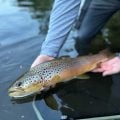Why Barbless Hooks are Better

Kirk Deeter wrote a piece recently over on the Trout Unlimited blog about the eight-fish limit on an English chalk stream he fished. That river required anglers to quit fishing after they’d caught and released eight fish in a day. Not caught and kept, but released. Deeter, in his blog, discusses how that idea would apply to American fisheries, and while I’m not sure it’s the right idea, it got me thinking about something we can do right now to benefit our fisheries and our fish.
Eliminate all barbs on fly hooks.
There’s absolutely no reason to fish with a barbed hook. Since I quit fishing with barbed hooks my fishing – heck, my life – has improved dramatically. I have a spring in my step. I’m noticing colors I didn’t before, and I finally lost those last 15 pounds that prevented me from looking svelte in pictures. The fish practically throw themselves in my net these days.
Obviously I’m kidding, but I promise my anti-barbs stance isn’t born from a highfalutin’ ideology.
Earlier this year, our local state news website Cowboy State Daily ran a story about a marked increase in injured trout along the Miracle Mile and Gray Reef sections of the North Platte. The story described a study by Wyoming Game & Fish biologists to determine how many trout have injuries from fish hooks. Along the Miracle Mile, 21.4% of trout had “noticeable injury” while 12.2% of trout were injured in the Gray Reef section.
Those injury rates only refer to injuries that biologists consider a 3 or 4 on a 0-4 severity scale. A trout with a 3 or 4 rating would have a mangled “mouth that could impede its ability to eat, injuries to the gills, broken jaws or destroyed eyeballs,” per the story. Taking into account all evidence of fish injuries, 72.6% of trout in the Miracle Mile and 64.6% in the Gray Reef were noticeably harmed in some way.
That’s simply not acceptable. It should be embarrassing for all of us that, on at least one fishery, we can easily quantify the non-lethal damage of bad fish handling. While barbed hooks aren’t the only culprit here, they play a major role.
I switched from barbed to barbless a few years ago, and almost immediately I noticed a big difference in how quickly I could get a fish out of the net and back in the river. A majority of the time, once I net a trout and release the tension on my fly line, the fly pops out of the fish’s mouth. In those cases I don’t even have to touch the fish, and it stays in the water as I release it. That’s the best-case scenario. And in the event I hook myself (it happens often enough) a barbless hook is much easier to remove, from both skin and clothing.
I distinctly remember a few fish that I mangled while trying to get my hook out. I know I’ve killed more than a few fish because I was in too much of a hurry to get my flies back. I wish I could say I’ve always handled fish well, but I haven’t.
There’s a fear among some anglers that, by using barbless hooks, they’ll lose more fish. In my experience, that’s an overblown concern. I don’t lose more fish now than I did when I fished barbed hooks. I know more than a few guides who only run barbless hooks in their boats, and they always manage to net enough trout.
Circling back to Deeter’s point that started this whole thought process, perhaps my guide friends catch too many fish. But that’s a discussion for another day. I firmly believe we can take better care of our trout than we currently do, and that starts with using barbless hooks. It’s a simple enough solution that I don’t understand why the industry hasn’t moved there already.
The Aquatic Insect Decline
The Best Rod for Small Streams











